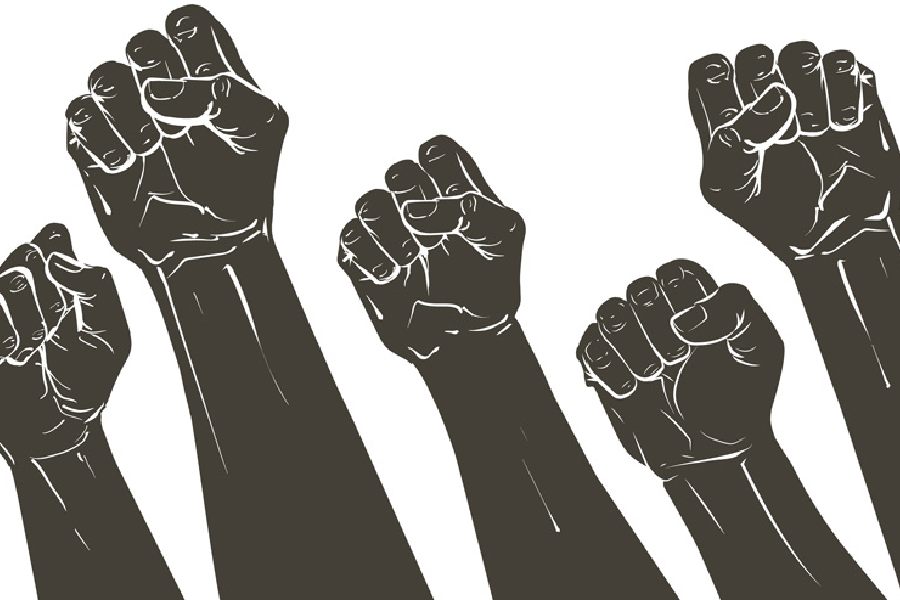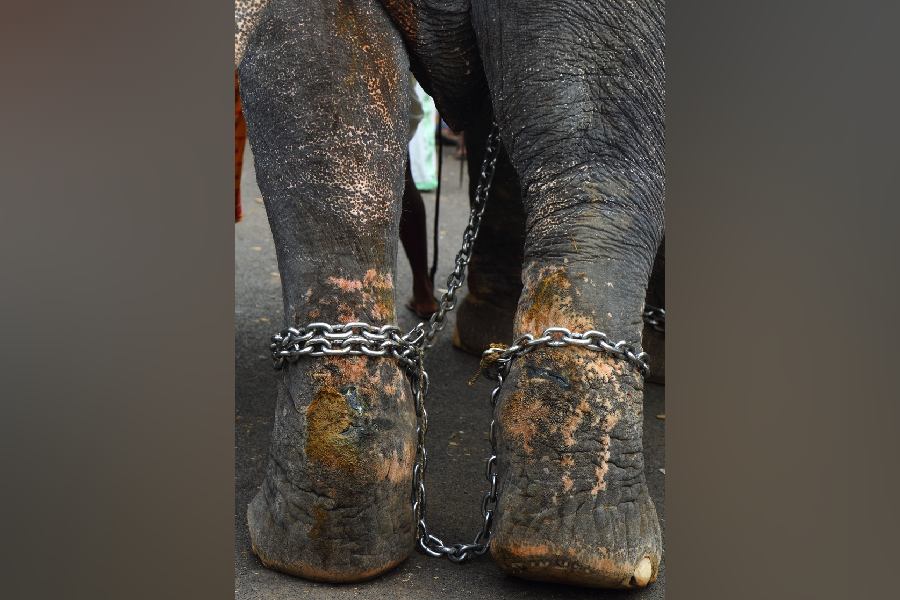 |
 |
 |
 |
In 1885, Jumbo, a pachyderm, died after a collision with a freight train in Ontario. The elephant had been bought from London’s Royal Zoological Society by P.T. Barnum, an imaginative circus impresario, who promptly ordered a taxidermist to preserve the animal’s hide and reassemble its skeleton. The following year, the remains of the elephant were exhibited widely during the circus season. They proved to be as big a sensation as the creature when it was alive. At a celebratory dinner, slices of the elephant’s left tusk that were inscribed with a laudatory message were presented as souvenirs.
I came across this anecdote about the showman, Barnum, and his elephant while reading a review in The Boston Globe of an art exhibition at the Bard Graduate Center that investigated the social links between the circus and New York. The article revived my interest in the circus — an integral element in Calcutta’s cultural map during the all-too-brief winter season — as a performance art that mirrors society’s complicated relationship with the anomalous. The Bard exhibition, reportedly, included posters of freaks and clowns, bearded infants and albino women, each individual a testimony to a culture’s simultaneous interest in and revulsion for such curiosities. A few days later, as I was being introduced to a midget, a man from Mayurbhanj, Odisha, who plays the role of the clown in the African Russian Famous Circus now stationed in Sinthee Maidan, I realized that my feelings — a strange mixture of sympathy, inquisitiveness and abomination — were perhaps not different from the sentiments of the audience that had been mesmerized by Barnum and his strange creatures.
The artist — Famous Circus’s equivalent of ‘General Tom Thumb’, a man who suffered from a form of dwarfism and was another of the attractions in Barnum’s circus — and I spent a leisurely hour talking about life and travelling shows. As we chatted, I could see that the other artists — jugglers, gymnasts, trapeze performers, animal trainers — were preparing languorously for yet another performance. Some of the Indian artists, men and women hailing from the hills, chatted in a circle around a cooking pot. The six lithe African men ambled around, occasionally cracking jokes. The Mongolian contingent, two women and one man, were applying make-up in an adjacent, sunlit tent. The elephants blew dust on themselves in a corner, even as the horses, one of them painted to resemble a zebra, grazed on the grass. I could not see either the birds or the hippopotamus, but I could hear the excited barking of dogs.
What I saw around me were scenes from a wonder world in which men and women from distant lands travelled, practised and performed together, challenging the differences that segregate people on the lines of faith, culture and class. In their free time, the artists experiment with cuisines, teach one another new tricks, and battle the monotony and solitude that come with incessant travelling by sharing prayers, stories, legends and music. Their ties with the management, I was told, are unambiguously democratic. Regular meetings are held to discuss payment, leave and demands to improve the infrastructure. Momentarily taken in by the promise of a utopia that survives on the equitable distribution of labour, power and profit, I had forgotten about the Russian artists. On enquiring, the manager revealed that they had been put up in a hotel. He also asked if I could arrange for a disability certificate for the man from Mayurbhanj. It is a pity that even a wonderland is not quite picture-perfect.
But the bonhomie among the artists as well as their solidarity with the management can be attributed to the fact that the circus is fighting a losing battle. The audience thins with every passing day. (I was one of the 70-odd people who attended the first show that afternoon.) Ticket sales are barely enough to meet expenses such as rent — Famous Circus is being charged approximately five lakh rupees per month for the private land at Sinthee Maidan, animal fodder and sundry payments for civic amenities.
The government’s indifference towards this form of public entertainment is inexplicable, given the fact that it continues to patronize several other kinds of artistic enterprises and artisan communities. For instance, Calcutta hosts a handicrafts fair every year, a platform that helps marginalized artisans and craftsmen to sell their products at competitive rates. This institutional apathy, however, reflects the tension between art and public entertainment. In a culture that invests minimal resources in both arts and in public entertainment, it is likely that refined art forms — visual arts and classical music — would command a greater share of respect and resources than the circus whose following continues to dwindle alarmingly. Significantly, it is not as if all kinds of public entertainment are accorded a step-motherly treatment. State governments have been known to announce tax sops for commercial films, but such a luxury continues to elude the circus.
Another dire need is that of adequate training facilities. There is an acute shortage of accredited vocational institutions that could impart skills to aspirants who want to perform in the circus. State intervention is also crucial to ensure that circus artists are not deprived of their basic labour rights by a management struggling to make ends meet. A close watch has to be kept on the employment of children as entertainers. Even as early as the 1870s, children were known to have been rescued from the hands of tyrannical circus employers.
The circus’s problems have been further compounded by the growing disinterest shown in it by such former allies as the working and middle classes in the city and the peasant community in the village. Two causal factors are at work here. The rising costs have forced circus-owners to raise the price of tickets, putting off the less affluent sections in both cities and villages. Second and more important, the middle class consumer — with considerable purchasing power — now has greater access to newer forms of technology such as digital films, online music and the internet, and is decidedly lukewarm in his/her response to the circus that relies more on human endeavour and skill than on technological wizardry. It is undeniable that structurally a circus performance combines tasteful aesthetics with clumsy machinery. The delightful sight of a trapeze artist cutting invisible arcs in the air is often marred by men heaving pulleys and nets in preparation for the next act.
But the circus’s survival is not only merited by the question of securing the livelihood of artists, or its importance as a tool for the cultural analysis of a society’s complicated relationship with ogres and curiosities, but also by the significance of the place the circus occupies in Bengal’s socio-economic and cultural history. Priyanath Bose’s Great Bengal Circus, a rare, inclusive institution, battled patriarchy by opening its doors to women performers.
Circuses are also known to recruit artists from village fairs, thereby sustaining the interest in performing arts and providing alternative sources of employment to marginalized communities. The death of the circus would thus spell doom for a rich legacy and also bring to an end a traditional avenue of employment for artists from the margins.
The circus serves as an excellent, but under-rated, agency to empower seemingly atypical people. What often goes unnoticed is the fact that when an audience laughs at the antics of a clown, it is the clown who forces the gathering to confront, albeit subtly, its prejudices and insensitivity toward the disabled and the deformed. Significantly, Barnum, who exploited society’s anxieties about the grotesque for profit, had realized the importance of according a degree of respectability to professionals employed in the circus. In 1841, he bought a museum that housed exhibits to help people understand the hardships faced by the artists and the difficulty of mastering the intricate tricks.
What is evident though is that the performers, the odds notwithstanding, are not ready to quit without putting up a fight. I had taken my seat — a dilapidated one — next to an old woman who was telling her grandson anxiously that they were seated too close to the stage that would soon be filled with ferocious beasts. The tigers and the lions, she was assured, have long (and mercifully) gone, but not the thrill that still runs through an audience just as the cackling loudspeaker comes to life with a marching tune and the arena is suddenly bathed in harsh light. The acts followed in a well-rehearsed sequence: the trapeze artists from the hills soared through the air, another artist juggled colourful balls, a Mongolian woman in a short, shiny costume performed with hoopla rings, elephants worked sums and worshipped a deity, with one of them devouring a bit of the garland that was supposed to be a part of the offering.
But the real magical quality that may help the circus endure these unsympathetic times unfolded once the African artists were introduced. The music changed to an infectious Afro-Caribbean beat, the crowd — shrieking children, excited parents, delighted elderly ladies — stood up and started to sway and clap even as the smiling visitors somersaulted inside the pit. The artists and the joyous audience, the animals and their handlers, the creaking trolleys and their sweaty operators, appeared to be willing prisoners inside a cheerful, bright tent that offered momentary shelter from the world outside.










